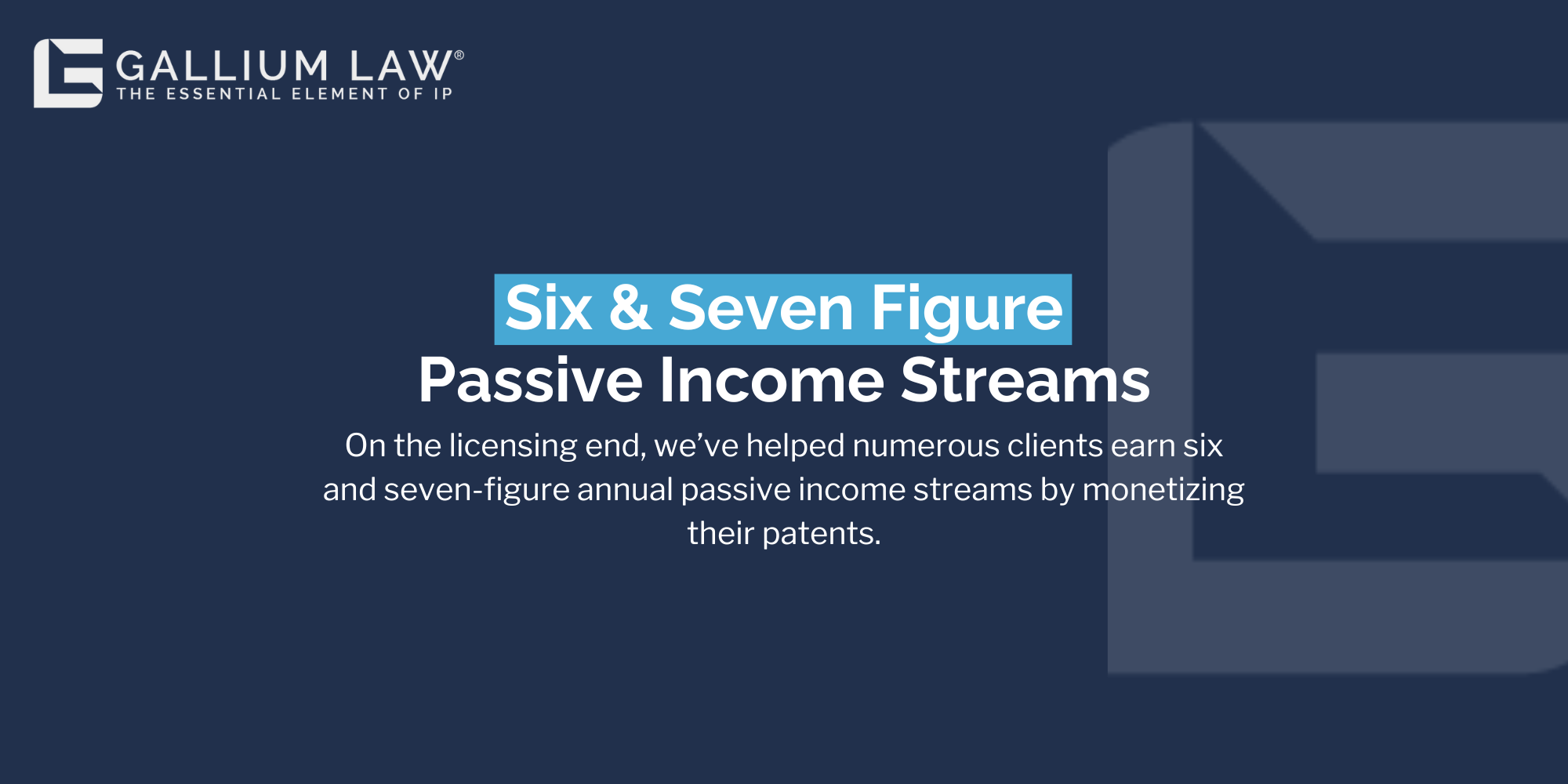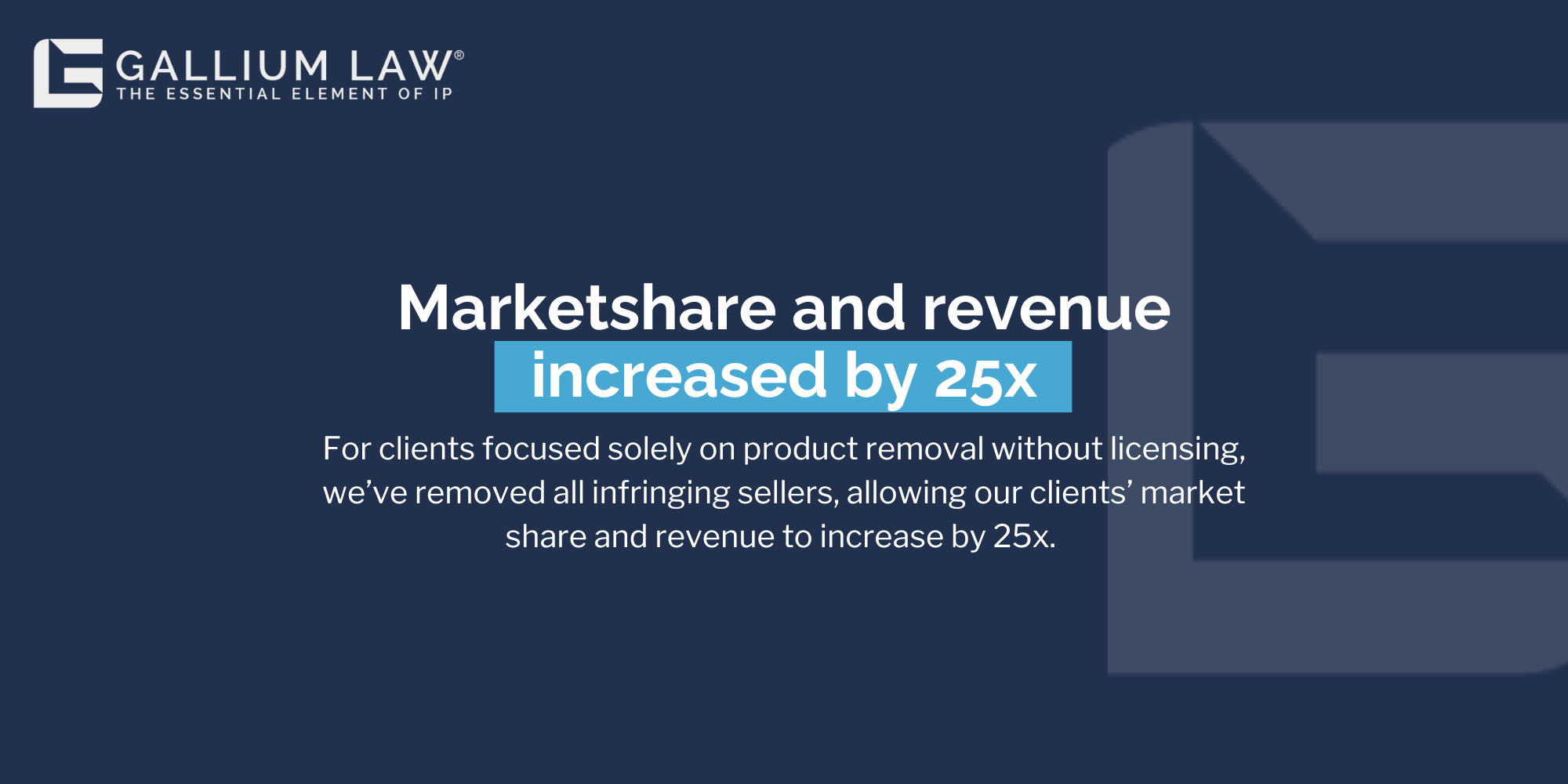Table of Contents

Connor Hance
August 2025

Anna Wengreen
August 2025

Nelson Lim
August 2025

Mike Lee
May 2025

Shawn
May 2025

Robert Paul
August 2024

Ryan Balko
September 2024

Daniel Bakke
August 2024

Gideon Eden
July 2023

David Morse
March 2024

Brady Hatcher
April 2023

Eric Wengreen
December 2022

Ashley Mooneyham
February 2022
Navigating IP Enforcement on Amazon: What You Need To Know
Amazon has transformed the way products are bought and sold, but it has also created fertile ground for intellectual property infringement. From knockoff designs to unauthorized sellers, the platform presents constant challenges for patent owners trying to protect their innovations. If you hold a utility or design patent and discover infringement on Amazon, you’re faced with a pivotal decision: Should you pursue product removal, or is licensing the better path?
At Gallium Law, we help clients weigh both options strategically. This guide explores the benefits, drawbacks, and legal nuances of licensing versus removal, so you can make an informed decision that aligns with your business goals and IP strategy.
Understanding the Nature of Amazon Infringement
Infringement on Amazon can take many forms: unauthorized sellers of patented goods, counterfeit products, or private-label products that closely mimic patented innovations. While Amazon does provide tools like Brand Registry and the APEX program to address these issues, the best course of action often depends on your business model, patent scope, and long-term goals.
Before choosing between removal and licensing, it’s important to understand what your patent protects and how the allegedly infringing product compares. This is where a detailed patent infringement analysis becomes crucial.

Option 1: Pursuing Product Removal via Amazon’s APEX Program
If your goal is to eliminate infringing products entirely, the Amazon Patent Evaluation Express (APEX) program is a streamlined enforcement tool. Created in 2019, the APEX program allows patent holders to challenge sellers of infringing products without going to court.
How It Works
Once a rights holder submits a complaint and applies to APEX, Amazon invites the seller to participate in a neutral patent evaluation. Both parties post a $4,000 deposit and submit written arguments to an independent IP attorney. If the evaluator determines the seller’s product likely infringes the patent, Amazon removes the listing.
When Removal Makes Sense
Product removal is ideal when:
- The seller is uncooperative or anonymous
- Licensing is not feasible due to price undercutting or reputational damage
- You want to send a deterrent signal to other potential infringers
- Your company also sells directly on Amazon and needs exclusivity
This approach is especially powerful for patented consumer products, medical devices, and software-enabled tools being sold by third parties without authorization.
If you’re interested in the full scope of how the APEX process works, our detailed page on Amazon intellectual property enforcement outlines each step.
Steps to Product Removal via Amazon’s APEX Program
Step 1: Identify Potential Infringement
Begin by locating listings that appear to infringe on your patented product or technology. Gather ASINs, screenshots, and purchase samples if necessary to confirm the similarity.
Step 2: Submit an Infringement Complaint
File a report through Amazon’s Brand Registry or IP portal. Include patent details, the ASINs in question, and a clear explanation of how the listing violates your patent rights.
Step 3: Apply to Participate in the APEX Program
Request entry into Amazon’s APEX (Amazon Patent Evaluation Express) Program. Once accepted, Amazon will notify the seller and invite them to join the neutral evaluation process.
Step 4: Sign the APEX Agreement and Pay the Deposit
Both parties must sign the APEX agreement and submit a $4,000 deposit to a neutral evaluator. The deposit is refunded to the winning party after the evaluation.
Step 5: Present Evidence and Written Arguments
Provide written arguments, claim charts, and supporting documentation showing how the product infringes your patent. The seller will then have an opportunity to respond, followed by your rebuttal.
Step 6: Receive the Evaluation Decision
The evaluator issues a binding decision. If you prevail, Amazon removes the infringing listing. If not, the seller’s listing remains active, but you can still explore other enforcement options such as litigation or licensing.
Option 2: Monetizing Your Patent Through Licensing
Licensing your patent to Amazon sellers is often a smart way to generate passive income without the burden of constant takedowns. Rather than seeking to permanently remove listings, you offer the seller a license to continue selling the product in exchange for royalties.
Benefits of Licensing
- Recurring Revenue: Turn infringement into an income stream
- Market Access: Let sellers do the work of listing, fulfillment, and customer service
- Reduced Enforcement Costs: Avoid repeated monitoring and APEX submissions
- Business Development: Form long-term partnerships with sellers who value legal compliance
Our team at Gallium Law supports clients by drafting tailored license agreements, calculating royalty structures based on sales volume, and enforcing license terms to ensure ongoing compliance.
Steps to Monetizing Your Patent Through Licensing
Step 1: Identify Infringing or Compatible Sellers
Search for sellers offering products that practice your patented technology. Focus on legitimate, well‑reviewed sellers who could become potential partners.
Step 2: Assess Commercial Potential and Royalty Value
Evaluate sales volume, pricing, and demand for the infringing products. This analysis helps determine a fair royalty rate or lump‑sum licensing fee.
Step 3: Initiate Contact and Open Negotiations
Reach out to sellers through Amazon’s communication channels, including the APEX program. Clearly state your patent rights and express willingness to discuss a licensing agreement rather than pursue removal.
Step 4: Draft and Negotiate a License Agreement
Work with experienced IP counsel to define scope, territory, duration, royalty structure, and reporting requirements. Include clear terms about product modifications, sublicensing, and termination.
Step 5: Monitor Compliance and Collect Royalties
Once the license is executed, regularly review the seller’s listings and sales reports. Verify royalty payments and ensure that license terms are followed.
Step 6: Expand Your Licensing Program
Use successful deals as a model for future licensing opportunities with other sellers. This creates scalable, recurring revenue and positions your IP as a monetized asset rather than a constant enforcement challenge.

Key Considerations Before Choosing
Choosing between licensing and removal is not just a legal decision—it’s a business one. Some of the factors to consider include:
- Product Type: High-margin, specialty products are often better suited for licensing. Commoditized or easily counterfeited goods may require removal to maintain brand integrity.
- Patent Strength: Weak or narrowly written claims may be challenged. In such cases, licensing can mitigate risk while preserving the patent’s value.
- Seller Reputation: If the seller has a strong Amazon presence, licensing might be more profitable. If they are anonymous or operate under multiple accounts, removal may be more effective.
- Enforcement Budget: APEX is relatively low-cost compared to litigation, but it still involves upfront effort. Licensing agreements, once in place, can create sustained value with less intervention.
If you’re unsure how strong your IP rights are, Gallium Law offers due diligence reviews and freedom-to-operate opinions to help you assess risk and opportunity.
Hybrid Strategy: Enforce, Then License
You don’t always have to choose one or the other. Many of our clients start with enforcement through APEX to establish leverage, then offer licenses to sellers who are willing to comply.
This hybrid approach can be especially effective when:
- Sellers initially resist enforcement but are open to negotiation
- You want to create a track record of enforcement to increase your licensing value
- You plan to scale licensing across multiple infringers
We also help clients develop custom enforcement plans that include portfolio management, licensing strategy, and litigation support if needed.
Common Legal Pitfalls and How to Avoid Them
Whether licensing or enforcing, it’s essential to avoid mistakes that could undermine your rights:
- Unclear Chain of Title: Before asserting your patent, ensure that ownership is properly documented. Our team can help verify and correct issues with assignment or inventorship records.
- Vague Licensing Terms: Licensing agreements must be precise about scope, duration, and geography to prevent future disputes.
- Non-Monitoring: If you choose to license, you still need to watch for unlicensed sellers. Gallium Law provides ongoing monitoring services to keep your IP protected.
Strategic Questions to Ask
To determine the best approach, ask yourself:
- Is it more valuable to dominate your niche or allow others to share the market?
- Can this seller provide distribution or visibility that would be hard for me to build?
- What kind of precedent do I want to set for future infringers?
The answers to these questions will help shape whether enforcement, licensing, or both will get you closer to your business goals.
Real Results: Client Success Stories
How Gallium Law Can Help
Our team is deeply experienced in Amazon-specific IP strategy. We understand what makes a patent enforceable on Amazon, how to use APEX effectively, and how to structure licensing agreements that deliver real value. Whether you want to defend your turf or unlock passive revenue, we’ll tailor a plan that fits your IP portfolio and your business goals.
We also offer support in:
- Trademark registration to access the Amazon Brand Registry
- Patent prosecution including software, design, and utility filings
- Startup consulting for companies bringing new products to market
To discuss your enforcement and licensing options, contact our team for a consultation.

Step 1: Detect Infringement
The APEX process begins when a patent owner discovers a product on Amazon that may infringe their U.S. utility patent. The owner gathers relevant documentation and prepares to file a formal complaint. This discovery typically triggers the start of Amazon’s internal evaluation timeline, which can move quickly once initiated.

Step 2: Submit a Complaint via Brand Registry
The patent owner submits a complaint through Amazon’s Brand Registry, accompanied by a request to participate in the APEX program. The request identifies the accused product(s) by their Amazon Standard Identification Numbers (ASINs) and includes an explanation of the alleged infringement. This explanation may be a written summary or a detailed claim chart. Only one patent claim may be asserted per submission, and separate requests are required for additional claims.

Step 3: Amazon Reviews the Complaint
Amazon reviews the submission and determines whether the patent qualifies for the APEX program. If accepted, Amazon invites the patent owner to sign the APEX Agreement and notifies the accused seller(s) of the pending evaluation. At this point, the parties may negotiate directly to resolve the matter. If a license is agreed upon, the complaint is withdrawn. If not, the seller can either participate in the APEX program or decline, if they decline, their product is removed from Amazon.

Step 4: Submit Arguments to the Evaluator
To proceed, both parties must submit a $4,000 deposit to a neutral evaluator—an experienced IP attorney appointed by Amazon. The evaluator receives written submissions from both sides, including evidence, claim charts, and legal arguments. The timeline generally allows three weeks for the patent owner’s initial submission, two weeks for the seller’s response, and one final rebuttal from the patent owner. The evaluator issues a decision with no opportunity for appeal, refunding the prevailing party’s deposit and removing or retaining the listing based on the outcome.

